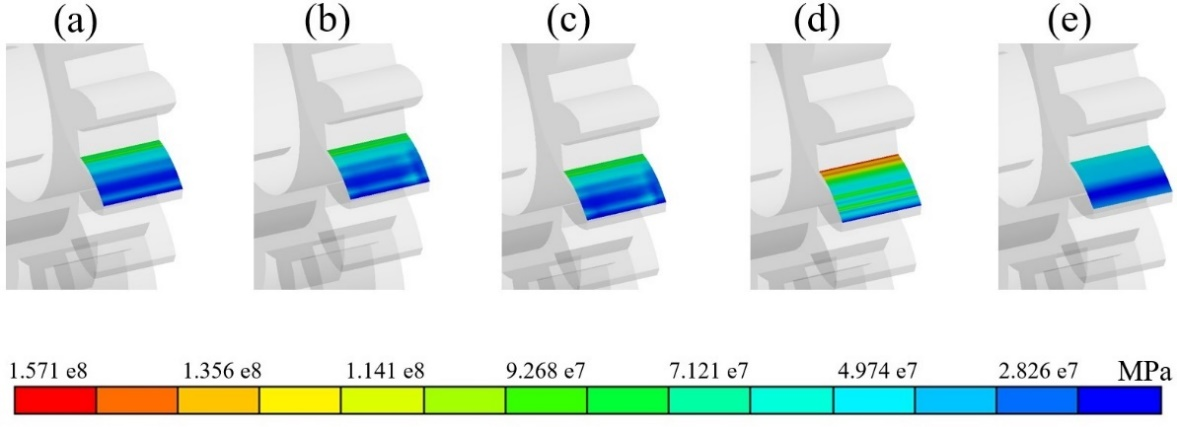Finite element modeling of fatigue in speed reducer gears with radial and axial misalignment
DOI:
https://doi.org/10.37636/recit.v328795Keywords:
Finite element, Gear fatigue, Radial and axial misalignment.Abstract
This paper presents a fatigue analysis of spur gears belong to speed reducers under radial and axial misalignment. The finite element method was employed to calculate the life cycles and the alternating stress in the spur gears. The misalignment was considered as a function of gear module, M. The radial misalignment was M0.2 and M0.5 and the axial misalignment was M0.2 and M0.3. The analyzed mechanism corresponds to the pinon and gear of the first stage of an all-terrain vehicle speed reducer. In both misalignment conditions, the maximum reduction of life cycles occurs in pinion gear due to high alternating stresses as torque increases. Changes in the contact zone due to gear misalignment cause stress concentrations in the face and root teeth.
Downloads
References
A. Jangid and S. Kumar, “Modelling and Simulation Analyses for Bending Stresses in Involute Spur Gears by Finite Element Method,” International Journal of Applied Engineering Research, vol. 13, no. 12, pp. 10914-10923, 2018. https://www.ripublication.com/ijaer18/ijaerv13n12_111.pdf.
Q. Wen, Q. Du and X. Zhai, “An analytical method for calculating the tooth surface contact stress of spur gears with tip relief,” International Journal of Mechanical Sciences, vol. 151, pp. 170-180, 2019. https://doi.org/10.1016/j.ijmecsci.2018.11.007 DOI: https://doi.org/10.1016/j.ijmecsci.2018.11.007
J. Eng, S. Karuppanan and S. Patil, “Frictional stress analysis of spur gear with misalignments,” Journal of Mechanical Engineering and Sciences, vol. 12, no. 2, pp. 3566-3580, 2018. https://doi.org/10.15282/jmes.12.2.2018.4.316 DOI: https://doi.org/10.15282/jmes.12.2.2018.4.316
Z. Hu and K. Mao, “An investigation of misalignment effects on the performance of acetal gears,” Tribology International, vol. 116, pp. 394-402, 2017. https://doi.org/10.1016/j.triboint.2017.07.029 DOI: https://doi.org/10.1016/j.triboint.2017.07.029
N. Ghazaly, A. Kamel and M.O. Mousa, “Influence of misalignment and backlash on spur gear using fem,” International Journal of Mechanical and Production Engineering, vol. 2, no. 12, 2014. https://www.semanticscholar.org/paper/INFLUENCE-OF-MISALIGNMENT-AND-BACKLASH-ON-SPUR-GEAR-Ghazaly-KAMEL/e9066a5e1f15c0d53b605813767c597e4d099472.
A. Amani, V. Spitas and C. Spitas, “Influence of centre distance deviation on the interference of a spur gear pair,” International Journal of Powertrains, vol. 4, no. 4. 2015. https://doi.org/10.1504/IJPT.2015.073785 DOI: https://doi.org/10.1504/IJPT.2015.073785
M.R. Lias, T.V. Rao, M Awang and M.A. Khan, “The Stress Distribution of Gear Tooth Due to Axial Misalignment Condition,” Journal of Applied Sciences, vol. 12, no. 23, pp.- 2404-2410, 2012. https://doi.org/10.3923/jas.2012.2404.2410 DOI: https://doi.org/10.3923/jas.2012.2404.2410
S. Li, “Effects of misalignment error, tooth modifications and transmitted torque on tooth engagements of a pair of spur gears,” Mechanism and Machine Theory, vol. 83, pp. 125-136. https://doi.org/10.1016/j.mechmachtheory.2014.09.011 DOI: https://doi.org/10.1016/j.mechmachtheory.2014.09.011
C. Campos, J.O. Dávalos, D. Cornejo and A. Villanueva, “Optimización del diseño de los engranes del reductor de un vehículo todo terreno,” Mundo Fesc, vol. 9, no. 18, pp. 16-23, 2019. https://www.fesc.edu.co/Revistas/OJS/index.php/mundofesc/article/view/443.
Brigs & Stratton (2019, Dec 15) Racing engines model 19 [Online]. Available: https://www.briggsracing.com/racing-engines/model-19
P.K. Purushottam, J. Rangaraya, C Tara and D. Sameer, “Life prediction of spur gear under fully reversed loading using total life approach and crack initiation method in FEM,” Aksaray University Journal of Science and Engineering, vol. 3, no. 2, pp. 82-98, 2019. https://doi.org/10.29002/asujse.498344. DOI: https://doi.org/10.29002/asujse.498344
S. Jeelani and M. Musial, “A study of cumulative fatigue damagein AISI 4130 steel,” Journal of Materials Science, vol. 21, pp. 2109-2113, 1986. https://doi.org/10.1007/BF00547954 DOI: https://doi.org/10.1007/BF00547954

Published
How to Cite
Issue
Section
Categories
License
Copyright (c) 2020 José Omar Dávalos Ramírez, Uzziel Caldiño Herrera, Shehret Tilvaldyev, Delfino Cornejo Monroy, David Luviano Cruz

This work is licensed under a Creative Commons Attribution 4.0 International License.
The authors who publish in this journal accept the following conditions:
The authors retain the copyright and assign to the journal the right of the first publication, with the work registered with the Creative Commons Attribution license 4.0, which allows third parties to use what is published as long as they mention the authorship of the work and the first publication in this magazine.
Authors may make other independent and additional contractual agreements for the non-exclusive distribution of the version of the article published in this journal (eg, include it in an institutional repository or publish it in a book) as long as they clearly indicate that the work it was first published in this magazine.
Authors are allowed and encouraged to share their work online (for example: in institutional repositories or personal web pages) before and during the manuscript submission process, as it can lead to productive exchanges, greater and more quick citation of published work (see The Effect of Open Access).











